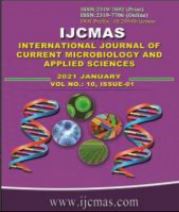


 National Academy of Agricultural Sciences (NAAS)
National Academy of Agricultural Sciences (NAAS)

|
PRINT ISSN : 2319-7692
Online ISSN : 2319-7706 Issues : 12 per year Publisher : Excellent Publishers Email : editorijcmas@gmail.com / submit@ijcmas.com Editor-in-chief: Dr.M.Prakash Index Copernicus ICV 2018: 95.39 NAAS RATING 2020: 5.38 |
Cotton (Gossypium hirsutum L.) has its unique reputation and name as the "King of fiber" and "White gold" because of its high economic value amongst cultivable crops. Cotton is a leading commercial and major cash crop of India. However, India’s average yield of 541 kg/ha (2016-17) is much lower than other top cotton growing nations. One of the main reasons for the low coverage of irrigation is the predominant usage of conventional technique of irrigation, where water use efficiency is very low. The irrigation efficiency can be enhanced by replacing surface irrigation with micro irrigation methods especially in arid and semi-arid regions. Water and fertilizer are the two important inputs for agricultural production and both have interacting effects on plant growth and yield. Since water and fertilizer are costly inputs, every effort must be made to enhance water and fertilizer use efficiency by reducing their wastage. So, attempts have been made in the present research work conducted at College of Agricultural Engineering and Technology, JAU, Junagadh during July, 2018 – February, 2019to study the response of Cotton (Gossypium hirsutum L.) crop to irrigation and fertigation and drip geometry. The experiment was undertaken with 9 treatments consisting of different combinations such as two irrigation levels (0.75 IW/ETc and 1.0 IW/ETc,), two dripper geometry (0.50 m spacing with 3 Lph discharge emitter and 0.60 m spacing with 4 Lph discharge emitter) and two fertilizer level (75% RDF and 100% RDF). Large plot design was adopted with three replications for each treatment. The response of cotton was evaluated in terms of no. of balls per plant, seed cotton yieldand water use efficiency. Results revealed that the highest no. of balls (38.40) and seed cotton yield (2569.38 kg/ha) were observed under dripper spacing of 0.60 m with 4 Lph discharge emitter in combination with irrigation level 1.0 IW/ETc and fertilizer level of 100% RDF. The present study leads to conclude that the farmers should cultivate the cotton crop by applying irrigation and fertigation through drip system (16 mm lateral of 1.2 m spacing x 4Lph x 0.6 m emitter spacing) at 1.0 IW/ETc (3 days interval) and 100 % RDF (N: P: K:: 240:050:150 kg/ha in 8 equal splits) for higher yield.
 |
 |
 |
 |
 |